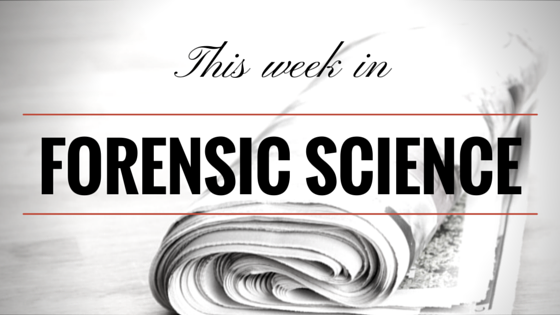No one has hours to scour the papers to keep up with the latest news, so we’ve curated the top news stories in the field of Forensic Science for this week. Here’s what you need to know to get out the door!
A Behind the Scenes Look at an MSP Forensic Lab (ABC 10 – 12/22/2016)
It’s located next to a cemetery in Marquette. Inside the big, tan colored building sits one of the most important resources for police officers and prosecutors in the area and in the state.
Lawmakers Try to Fix a Side Effect of Reducing Drug and Theft Crimes: Not Enough DNA Samples for Cold Cases (Los Angeles Times – 12/22/2016)
California lawmakers are once again trying to expand the collection of DNA evidence in criminal cases, something they say has declined under Proposition 47, hurting cold rape and murder investigations.
DNA Testing Limits Overturned by Ohio Supreme Court (Governing – 12/22/2016)
The Ohio Supreme Court leveled the playing field for DNA testing in murder cases today by ruling part of state law unconstitutional.
Inside the DEA: A Chemist’s Quest to Identify Mystery Drugs (Forensic Magazine – 12/22/2016)
The proliferation of rapidly evolving synthetic opioids has become so fierce that the DEA says they now constitute an entire new class of drugs, which are fueling the deadliest addiction crisis the United States has ever seen.
Why We’re Closer Than Ever to a Timeline for Human Evolution (The Guardian – 12/22/2016)
Dating when our ancestors split from Neanderthals and other relatives has long been a puzzle, but DNA advances are making our evolutionary journey clearer
For Science! World’s Oldest Mummies Get a DNA Scan (Sputnik News – 12/26/2016)
Chilean researchers conducted an extensive genetic analysis of mummies embalmed by the Chinchorro people over 7,000 years ago.
In Texas, A Database of Exhumed Objects Aims to ID Migrants Who Perished (NPR – 12/26/2016)
This is one of 80 cases featured on the website of The Texas Observer, the venerable progressive magazine published in Austin for the past 62 years. The idea is to create a small, searchable database where relatives can go to find photos of personal items associated with their missing loved one — a brother, sister, or son who trekked to el norte, never to be heard from again.
Researchers Estimate Time Since Death Using Necrobiome (Forensic Magazine – 12/27/2016)
Currently, when a deceased human is discovered, the forensic techniques for estimating time elapsed since death is not very precise. However, in a new study appearing in the journal PLOS ONE, researchers have turned to analyzing the human microbiome, the bacteria and other microbes that live on and in our bodies, for clues about the postmortem interval of a cadaver.
Making Sense of Disasters: Forensic Engineering Certificate First in Canada (Forensic Magazine – 12/27/2016)
Forensic engineers are trained to find and analyse data from disasters, accidents and failures, and present an unbiased assessment of what the underlying cause may have been.
Carnegie Mellon Scientists Use Brain Scan Data to Study Facial Recognition (Forensic Magazine – 12/27/2016)
A team at Carnegie Mellon University is now looking at the millisecond-by-millisecond process of recognition through brain scans – and comparing the neural data to artificial intelligence systems.
84 Dublin Taxi Drivers Being Asked for DNA Samples After Alleged Rape (Irish Examiner – 12/27/2016)
Eighty-four taxi drivers in Dublin are being asked for DNA samples after an alleged rape.
The men have been chosen because their cars match the make and model of the suspect’s vehicle.
The Irish Times says today that the attack was reported by a woman after a night out on December 11 last year.
State Audit Shows Nearly Half of Rape Kits Not Tested (Idaho Press-Tribune – 12/27/2016)
Nearly half of Idaho’s alleged sexual assault victims who underwent a forensic exam after reporting their case to authorities never had those results submitted to a lab for testing.
2017: Ideas Whose Time Has Come and Gone (Forensic Magazine – 12/28/2016)
We here in the NIST public affairs office thought it might be fun to list some of the NIST-relevant scientific ideas that we think are on their way in and out in 2017. While the items on the list below may not be as monumental as the discoveries that led to this year’s Nobel Prizes, MacArthur Foundation “genius” grants or Breakthrough Prizes, we still think they’re pretty important and could contribute to a better future.
Look Inside the World’s Only Forensic Lab that Investigates Wildlife Crimes (Metro – 12/28/2016)
The lab, which is based in Ashland in the US state of Oregon, was set up in 1988 by the US Fish & Wildlife Service Office of Law Enforcement (USFWS) to to scientifically analyse violations of federal wildlife protection laws.
Will DNA Test Solve Habsburg Imperial Mystery? (BBC – 12/29/2016)
A Czech DNA expert is carrying out tests on clothes belonging to the first president of Czechoslovakia, Tomas Garrigue Masaryk.
The tests should provide a definitive answer to an explosive claim that has fascinated readers and troubled historians for almost a century. Was Masaryk – champion of Slav rights and father of the Czechoslovak state – the illegitimate son of the Austro-Hungarian emperor?
WOULD YOU LIKE TO SEE MORE ARTICLES LIKE THIS? SUBSCRIBE TO THE ISHI BLOG BELOW!
SUBSCRIBE NOW!


